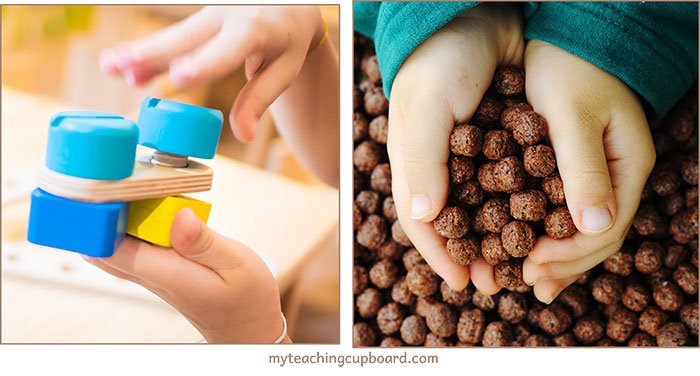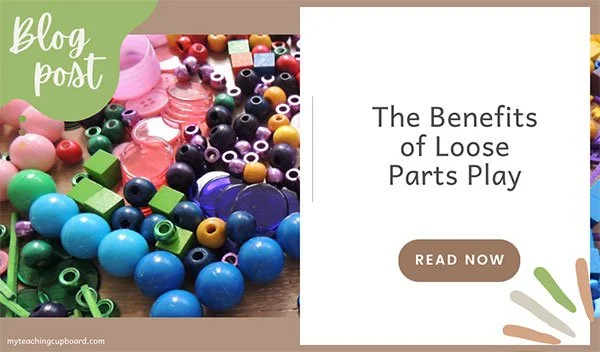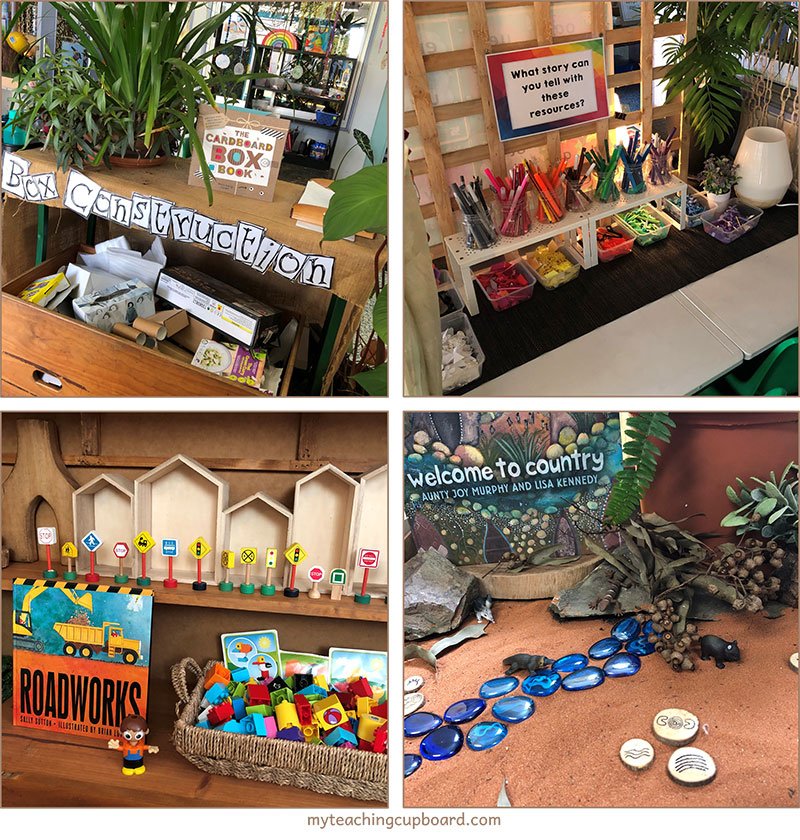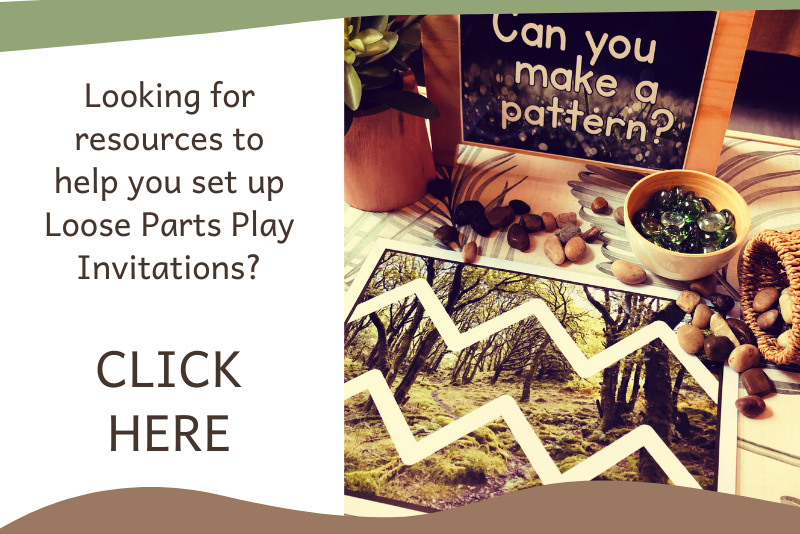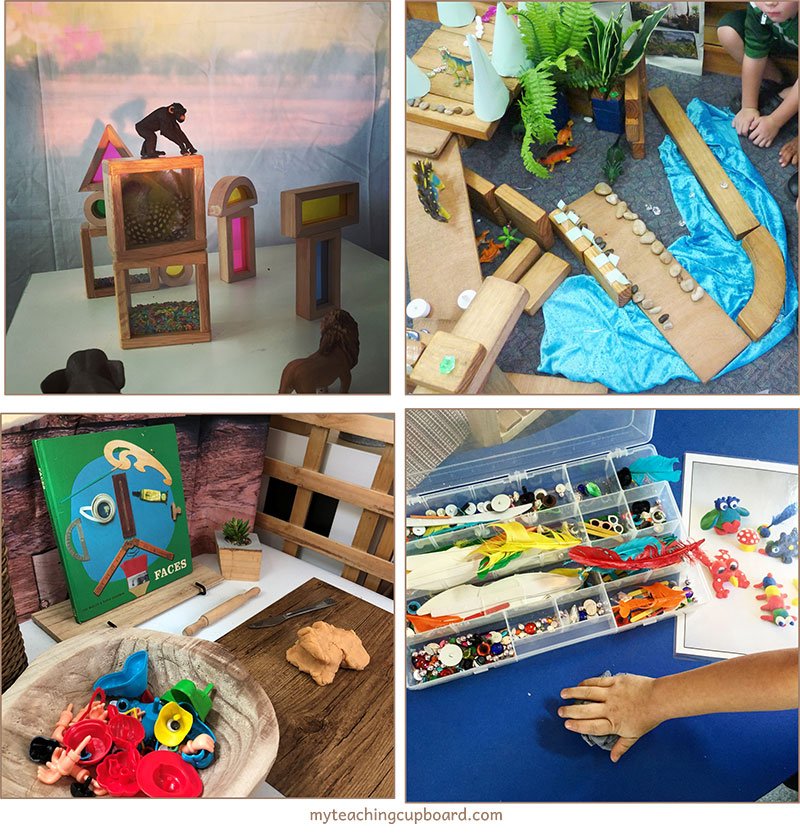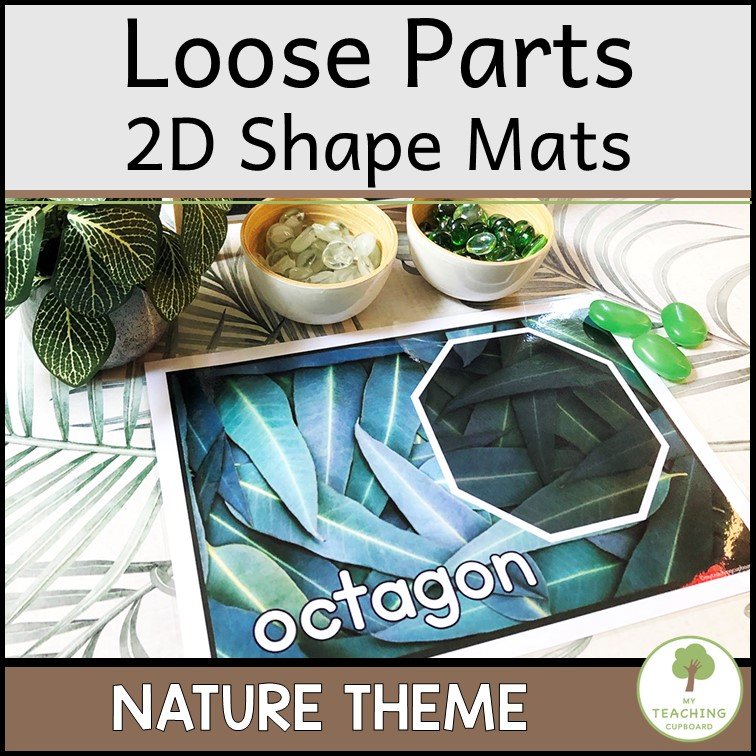Loose Parts Play
Are you interested in learning more about loose parts play?
In this blog post you will find out what loose parts are and where the idea of loose parts play originated.
You will also discover the benefits of loose parts play and get some ideas on how you can encourage loose parts play in your classroom.
This blog post will also give you some practical teaching and implementation tips so you and your children can easily get started with loose parts play today.
What are loose parts?
In 1971, an architect named Simon Nicholson developed the theory of loose parts. He defined loose parts as any open-ended materials which encourage creativity and exploration in children. Nicholson suggested children will manipulate and use loose parts during investigative play experiences.
For optimal learning to occur, the key is to ensure the loose parts you provide are open-ended in nature.
There are many types of loose parts. Loose parts can be natural or man-made. They can be large like tyres or small like beads. Loose parts options are endless. There is a vast selection of items you can choose from when you are collecting loose parts for your learning environment. Items like wooden blocks, shells, bottle tops, cotton wool, scraps of fabric — the list goes on and on.
If you would like a loose parts play resources list, you should check out this blog post for a comprehensive list of over 150 loose parts that I have collected and used in my play based classroom, CLICK HERE - Loose Parts Play Resources List.
When collecting loose parts, keep in mind that your loose parts can be used in a variety of ways and for numerous purposes. Your children will love the sensory aspect of loose parts. They will also enjoy manipulating them and discovering how they can turn these everyday items into anything their imagination allows.
Loose parts collections can be completely random, or you can put together collections around specific themes. For example, items could be all the same colour, all come from the kitchen, all soft materials or all from nature and found outside.
What is Loose Parts Play?
The term Loose Parts Play was first introduced by Simon Nicholson and his Theory of Loose Parts. His theory explains that loose parts play is the activity of children manipulating and using open-ended materials as they play.
Nicholson strongly believed that the “loose parts” within our environment help us to form connections and discovering those connections fuels creativity. He suggests that loose parts play is important for cognitive development and develops critical skills necessary to what we now call STEM (Science, Technology, Engineering, and Math) Education.
Nicholson’s Theory of Loose Parts also suggests that loose parts play helps children develop fine motor and gross motor skills as they manipulate and use the loose parts.
What are the benefits of loose parts play?
Loose parts play can develop skills across your entire curriculum – literacy, maths, art, science, and more. It is also cross-curricular or an integrated pedagogy because so many learning intentions will be covered in any one learning experience.
There are benefits for both the child and for the teacher.
In loose parts play children will observe, enquire, investigate, construct, deconstruct and engage with both others and the world around them. They will apply their knowledge and understandings to their play. The teacher as an observer of loose parts play can discover valuable information about the children and their developmental levels.
There are many benefits of loose parts play. So many that I have written another blog post just on the benefits of loose parts play. If you are interested in reading it, CLICK HERE - Benefits of Loose Parts Play.
How do you encourage loose parts play?
With all of these loose parts play benefits you are no doubt interested in implementing some of this goodness into your early childhood classroom.
It is best to have loose parts always available to your children during investigative play sessions. When children can freely access the loose parts, they are more likely to use them and incorporate them into all kinds of learning experiences.
You can offer as many pieces or collections of loose parts as you wish. After a couple of days of observations, you will have a better idea of how many pieces work best for your children.
You might like to dedicate a bookshelf in your classroom just for loose parts storage. You can also add a few random baskets of loose parts to a specific investigation area. Experiment and find what works best for your class.
Children will count the loose parts, use them to create patterns, balance and build with them, take them apart and put them back together. There is no right or wrong way for children to explore loose parts. Your role is to observe, encourage and scaffold a child’s loose parts play.
One of our favourite learning provocations to encourage loose parts play is to simply offer a selection of loose parts in a divided tray. This simple provocation provides children with opportunities for creative expression and is a form of storytelling. It has links to both the arts and literacy curriculum.
Loris Malaguzzi from Reggio Emelia, suggests that children have a hundred languages in which to explore, create and express themselves and loose parts are the ideal medium to allow them this expression. If you would like to learn more about the hundred languages of children, you might be interested in this blog post – The 100 Languages of Children.
You can add loose parts like shells, corks, buttons, feathers, bottle tops and leaves into a divided tray. The loose parts are separated in the tray so an emphasis is placed on each material and so the children will be more purposeful in their choices. The children can create many different stories and art works with the same loose parts.
Tips for Teachers Getting Started with Loose Parts Play
The primary aim of loose parts play is to give children the opportunity to expand their thinking and investigative play skills and loose parts play does this easily and effectively.
To begin using loose parts start by adding some to one of your investigative play areas. The blocks and play dough areas lend themselves well to loose parts. Discuss with children the rules and routines around tidying up and managing the loose parts.
Introduce one type of loose part at a time. You might like to start with a more durable, larger sized loose part like wooden branch cookies. When children can use these safely, introduce more fragile and smaller pieces like glass stones. You know your children best. Always consider their age and independence. Some loose parts are choking hazards and will require risk assessments on your part.
Thoughtfully select the loose parts you offer and the way they are displayed. The way they are displayed will influence the way they are used. Displaying your loose parts in divided trays or individual bowls and baskets, which themselves create interest, will suggest the value of the loose parts resources. Children will be encouraged to take more care with these special items. They will also be more likely to use them respectfully and with thoughtful intent.
During tuning-in and reflection times, discuss and model the correct use of the resources. This is also an ideal time to highlight and encourage ways you have observed children using the loose parts to practice and revise current curriculum learning intentions.
Organise and display loose parts based on themes and attributes like colours, textures and sounds. Include collections related to children’s interests and curriculum themes like sea creatures or items that sink and float.
When offering loose parts in your learning invitations, consider the storage and display options you use. For optimal engagement and purposeful use by the children, keep your loose parts invitations inviting, clearly organised and able to be easily packed away by the children.
Encourage the children to collect loose parts to add to the classroom. We have quite a collection of seed pods and feathers which children have collected from the playground and on weekend adventures with their families. Involving children in gathering and sourcing classroom resources is a fantastic way to foster children’s ownership in their learning and a classroom community.
Take your loose parts play to the next level
Look at your investigative play spaces with a 3D perspective. Don’t just offer loose parts at a designated desk or table. Consider all the levels each learning area has.
Floor Level. Add rugs and placemats to define the investigation area. Add slightly raised platforms if you are looking to extend loose parts play. Add tables and boxes to the floor space to create dens and cubbies where loose parts can be explored.
Waist height at a table or on a wall. Add small tables of different heights and add platforms to your tables to vary the height of the child’s working area. Don’t forget to utilise wall spaces, easels and vertical surfaces. Simply changing the angle of a vertical surface can encourage children to explore loose parts in a different way.
Headspace and arm’s reach. Loose parts can be hung and stored overhead and within reach. This is especially good for softer loose parts like fabric. Offering loose parts in a different or unexpected way can stimulate children’s creative thinking and spark new learning experiences.
Add a variety of containers to your loose parts play. Children will fill them, transport other loose parts, use them to measure and sort their loose parts and even use the containers as loose parts themselves.
Loose parts play will be easy and quick to set up in your classroom with these loose parts play mats. Simply download and print for instant classroom loose parts resources. Just add a tray of loose parts and your children will be learning through loose parts play in no time.
Now you know what loose parts are and what loose parts play is, you might be interested in learning more. If so, check out these other blog posts on loose parts
If you enjoyed this blog post on Loose Parts Play, please consider sharing it...
Just CLICK the sharing box below.👇




